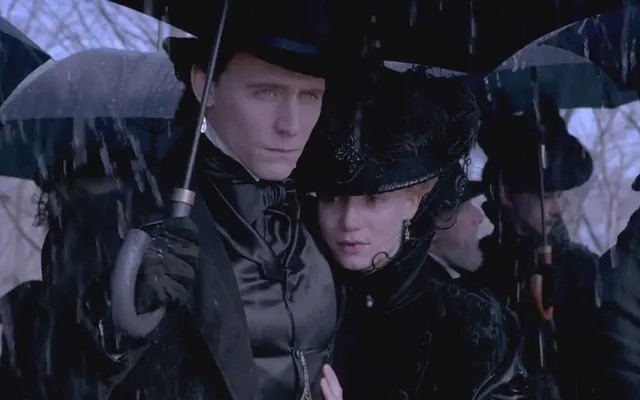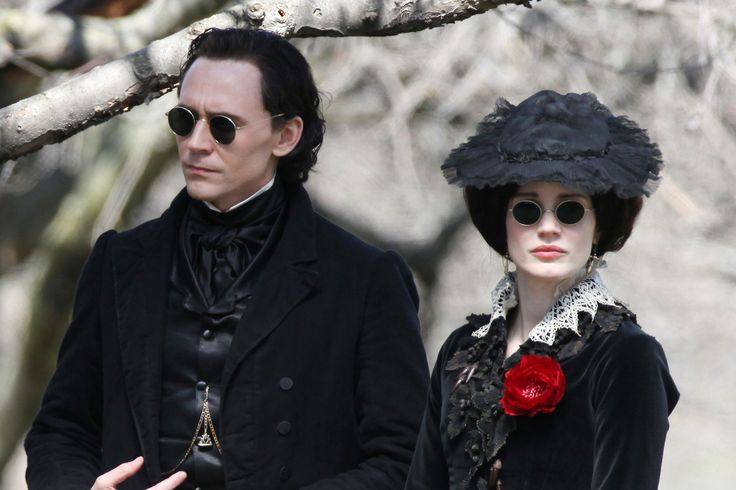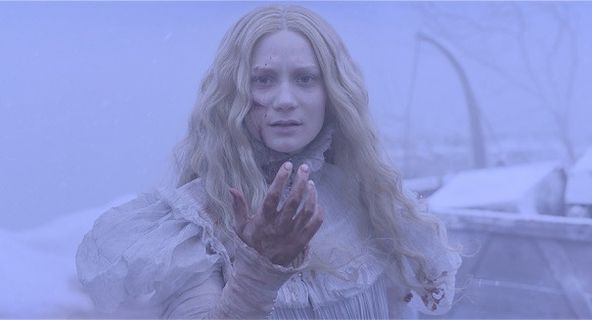Crimson Peak (2015)

Crimson Peak (2015) is a visually stunning gothic horror film directed by Guillermo del Toro, who co-wrote the screenplay with Matthew Robbins. Known for his unique style and imaginative world-building, del Toro creates a haunting and visually immersive experience that combines elements of romance, mystery, and supernatural horror. Set in the late 19th century, the film stars Mia Wasikowska, Tom Hiddleston, Jessica Chastain, Charlie Hunnam, and Jim Beaver. Produced by Legendary Pictures and distributed by Universal Pictures, Crimson Peak invites audiences into a world where love, loss, and death intertwine in eerie and unsettling ways.
The film follows Edith Cushing, played by Mia Wasikowska, a young woman from a wealthy family in New York. After the death of her father, Edith becomes entangled in a passionate and tragic romance with Sir Thomas Sharpe (Tom Hiddleston), a mysterious English aristocrat. Thomas, along with his sister Lucille (Jessica Chastain), takes Edith to their crumbling mansion in the remote English countryside. The house, known as Crimson Peak due to its blood-red clay foundations, is as much a character in the story as the people themselves, with its decaying walls and eerie atmosphere setting the stage for the unraveling of dark family secrets.
One of the most captivating aspects of Crimson Peak is its visual design. Del Toro’s meticulous attention to detail is evident in every frame, with the film’s production design, costumes, and color palette evoking a sense of gothic grandeur and decay. The mansion, a sprawling, decaying estate surrounded by desolate landscapes, is bathed in haunting reds, dark greens, and misty greys, reflecting the emotional turmoil and supernatural presence that looms within. The house itself seems alive, shifting and creaking, as though it has its own secrets to reveal. Del Toro’s use of practical effects and set design gives the film a tactile, almost tangible quality, immersing the viewer in its world.
The performances in Crimson Peak are another key strength of the film. Mia Wasikowska brings a sense of vulnerability and strength to her role as Edith, a young woman torn between love and suspicion. Her character’s transformation from an innocent dreamer to a woman who confronts the horrors of her new life is both tragic and compelling. Tom Hiddleston’s portrayal of Thomas Sharpe is filled with charm and mystery, his character hiding secrets beneath his seemingly gentle exterior. Hiddleston’s performance adds layers of ambiguity, making Thomas both sympathetic and unsettling. Jessica Chastain as Lucille Sharpe delivers a chilling and memorable performance as the cold, calculating sister who harbors her own dark intentions.

The film’s thematic exploration of love, loss, and betrayal adds depth to its gothic horror elements. Crimson Peak is not merely a story about ghosts and haunted houses; it is about the consequences of unchecked ambition, the destructive power of secrets, and the complexities of familial relationships. The relationship between Edith and Thomas is marked by passion and tragedy, but it is the haunting presence of Lucille that drives much of the story’s darker themes. Lucille’s twisted love for her brother and her desire for control over the estate reflect the destructive potential of possessive relationships, making her a truly terrifying figure in the narrative.

At the heart of Crimson Peak is the notion of the past haunting the present. The ghosts that haunt the mansion are not just spectral entities; they are manifestations of unresolved trauma, guilt, and betrayal. As Edith uncovers the truth behind the Sharpe family’s dark history, the spirits of the house reveal the painful and tragic consequences of past actions. Del Toro uses the ghosts as metaphors for the emotional and psychological weight carried by the characters, particularly Edith, who must confront her own notions of love and trust in the face of betrayal and violence.
The film’s pacing is deliberate, allowing the tension to build gradually as the supernatural elements become more pronounced. Unlike many modern horror films, Crimson Peak does not rely on jump scares or excessive gore to elicit fear. Instead, it builds its terror through atmosphere, character development, and an ever-present sense of dread. The supernatural elements are intricately woven into the fabric of the story, creating a slow-burn horror experience that culminates in a shocking and emotional finale. This more subtle approach to horror sets Crimson Peak apart from other films in the genre, giving it a more sophisticated and psychological edge.

In conclusion, Crimson Peak is a hauntingly beautiful film that combines elements of gothic romance with supernatural horror. Guillermo del Toro’s direction, coupled with stunning performances from Mia Wasikowska, Tom Hiddleston, and Jessica Chastain, creates a deeply atmospheric and emotionally resonant narrative. The film’s exploration of love, loss, betrayal, and the past’s lingering presence makes it a memorable entry in the gothic horror genre. With its meticulously crafted visuals, strong performances, and rich thematic content, Crimson Peak is a film that lingers long after the credits roll, leaving viewers to reflect on the dark consequences of love and the power of the past.











